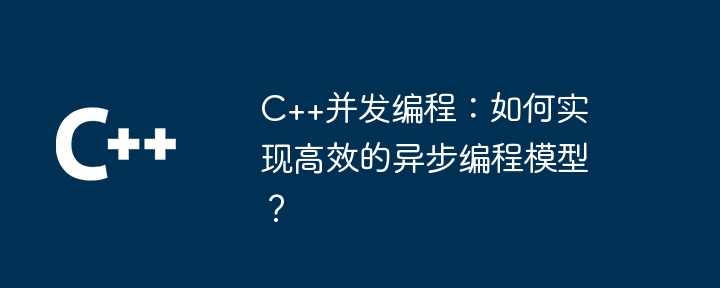
Asynchronous programming improves responsiveness and can be implemented in C through: Coroutines: lightweight collaborative tasks, created and managed using coroutine libraries such as Folly. Future: represents the result of an asynchronous operation, created and managed using the Future library (such as std::future). Non-blocking model: Coroutines and Future are combined to achieve non-blocking solutions. By using Future to represent the results of asynchronous operations, the calling thread is prevented from being blocked.

C Concurrent Programming: Implementing an Efficient Asynchronous Programming Model
In modern software development, asynchronous programming has become crucial, Because it improves responsiveness, throughput, and resource utilization. This article will introduce how to use coroutines and Future to implement an efficient asynchronous programming model in C.
Coroutine: lightweight collaborative tasks
Coroutine is a lightweight user-mode thread that allows multiple tasks to be executed concurrently in the same thread . Coroutines transfer control to the scheduler by explicitly suspending operations, thus avoiding expensive context switching overhead.
In C, you can use a coroutine library (such as Folly) to create and manage coroutines. Here is an example of creating a coroutine using Folly:
folly::coro::Task<> task = folly::coro::makeTask([]() -> folly::coro::Task<void> {
// 协程执行体
});Future: the result of an asynchronous operation
Future is a type that represents the result of an asynchronous operation. It provides access to the results and the ability to wait on them without blocking the calling thread.
In C, you can use Future libraries (such as std::future or Folly::Future) to create and manage Futures. The following is an example of using std::future to create a Future:
std::future<int> future = std::async(std::launch::async, []() {
// 执行异步操作
return 42;
});Asynchronous Programming Model: Practical Case
Now, let us see how to combine coroutines and Future Combined to create an efficient asynchronous programming model.
Consider the following use case: We need to get some data from a database and send it to a remote server. Traditional methods will block the calling thread, resulting in performance degradation.
Using coroutines and Future, we can implement a non-blocking solution:
folly::coro::Task<> task = folly::coro::makeTask([&]() -> folly::coro::Task<void> {
auto data = co_await getDataFromDB();
co_await sendDataToRemoteServer(data);
});In this model, getDataFromDB and sendDataToRemoteServer are coroutine functions that use Future to represent the results of asynchronous operations. The calling thread will start the coroutine task and can then continue to perform other tasks, while the coroutine task will execute in the background.
When the asynchronous operation is completed, the coroutine task will resume execution and update the result of the Future. The calling thread can obtain the result by calling Future's get() method.
Conclusion
By using coroutines and Futures, we can implement an efficient asynchronous programming model, which can improve responsiveness, throughput, and resource utilization. The practical examples presented in this article demonstrate how to use coroutines and Futures to solve real-world problems and provide a blueprint for writing efficient and scalable concurrent applications.
The above is the detailed content of C++ concurrent programming: How to implement an efficient asynchronous programming model?. For more information, please follow other related articles on the PHP Chinese website!
 What are the differences between c++ and c language
What are the differences between c++ and c language
 Recommended learning order for c++ and python
Recommended learning order for c++ and python
 Cost-effectiveness analysis of learning python and c++
Cost-effectiveness analysis of learning python and c++
 Is c language the same as c++?
Is c language the same as c++?
 Which is better to learn first, c language or c++?
Which is better to learn first, c language or c++?
 The difference and connection between c language and c++
The difference and connection between c language and c++
 C++ software Chinese change tutorial
C++ software Chinese change tutorial
 Cost-effectiveness analysis of learning python, java and c++
Cost-effectiveness analysis of learning python, java and c++




